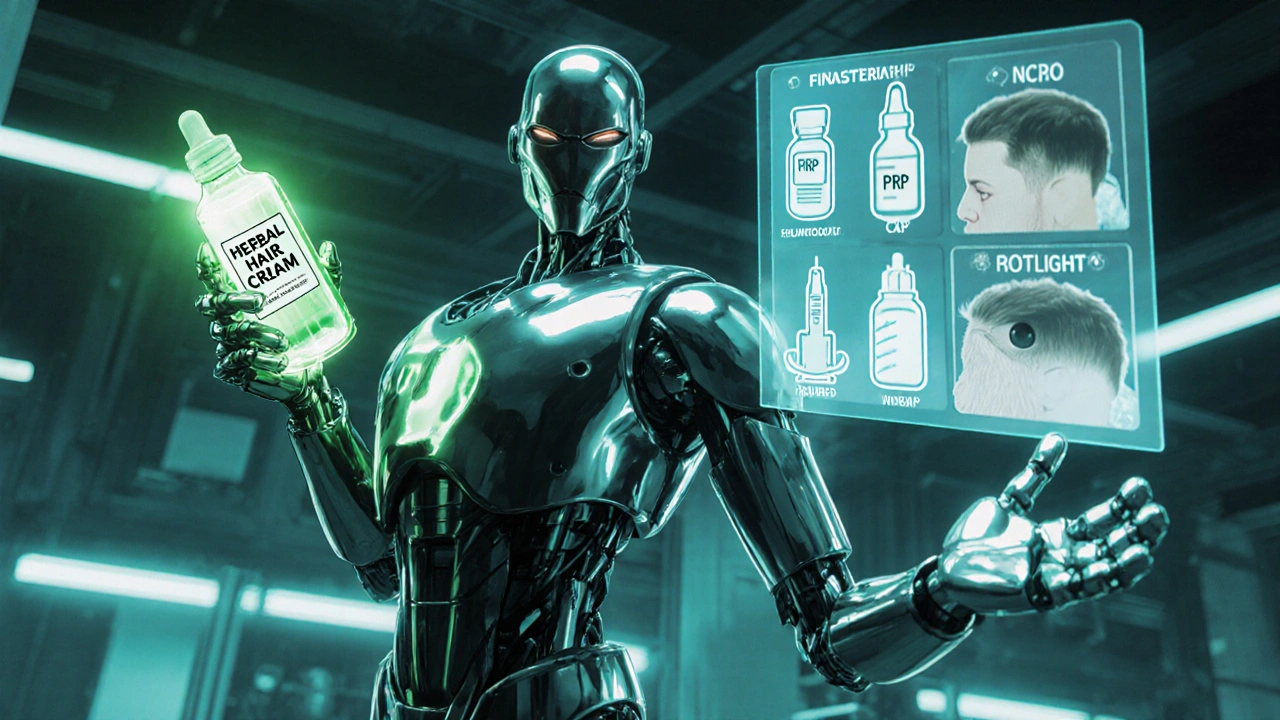
Hair Loss Treatment Comparison Tool
Find Your Best Treatment Option
Answer a few questions to see which hair loss treatments match your needs.
Recommended Treatments
Based on your selections, these treatments are best suited for your situation.
If you’ve been scrolling through product pages and forums, you’ve probably seen a flood of hair‑loss solutions promising miracles. The buzz around herbal hair loss cream is especially loud, but how does it really stack up against the more traditional options? In the next few minutes we’ll break down the science, costs, side‑effects and real‑world results so you can decide what actually works for you.
What exactly is a herbal hair loss cream?
Herbal Hair Loss Cream is a topical formulation that blends plant‑derived extracts, essential oils and sometimes vitamins to target the scalp. The idea is simple: natural compounds can calm inflammation, block the hormone DHT (dihydrotestosterone) that shrinks hair follicles, and stimulate blood flow. Common ingredients include saw palmetto, rosemary oil, green tea extract, and caffeine. They’re usually free of synthetic hormones or harsh chemicals, which makes them attractive to people who prefer a gentler approach.
How do the alternatives work?
To figure out whether a herbal cream is worth it, you need a baseline of how the other major treatments fight hair loss.
- Minoxidil is a vasodilator that was originally used for high blood pressure. When applied to the scalp, it widens blood vessels, delivering more oxygen and nutrients to follicles. It’s the active ingredient in over‑the‑counter products like Rogaine.
- Finasteride is an oral prescription that blocks the enzyme 5‑alpha‑reducing testosterone to DHT, dramatically lowering the hormone that triggers androgenic alopecia.
- Platelet‑Rich Plasma (PRP) therapy draws a small amount of your blood, spins it to concentrate platelets, then injects the plasma into the scalp. Growth factors in the platelets are thought to reboot dormant follicles.
- Low‑Level Laser Therapy (LLLT) uses red‑light devices (combs, caps, helmets) to energize cells in the scalp, increasing ATP production and encouraging hair growth.
- Hair Transplant Surgery moves healthy follicles from a dense area (usually the back of the head) to balding zones, offering a permanent physical solution.
Decision‑making criteria
When you compare anything, you need a clear checklist. Here are the five factors most people weigh:
- Effectiveness - Does the treatment actually grow new hair or just slow loss?
- Safety & side‑effects - Are there risks that could outweigh the benefits?
- Cost - What’s the price over a typical 12‑month period?
- Convenience - How easy is it to stick with the regimen?
- Long‑term outlook - Will results last after you stop using it?
Let’s see how the herbal cream measures up against each of the alternatives using these criteria.
| Treatment | Active Ingredients | Mechanism | Effectiveness* | Typical 12‑Month Cost (AUD) | Common Side‑effects |
|---|---|---|---|---|---|
| Herbal Hair Loss Cream | Saw palmetto, rosemary oil, green tea, caffeine | DHT inhibition, anti‑inflammatory, scalp circulation | Moderate - 30‑45% users see reduced shedding | $120‑$250 | Rare skin irritation, allergic reaction |
| Minoxidil (2%/5%) | Minoxidil | Vasodilation, follicle enlargement | High - 40‑60% see visible regrowth | $150‑$300 | Scalp itching, dry flakes, hypertrichosis (unwanted hair) |
| Finasteride (1 mg) | Finasteride | 5‑α‑reductase inhibition, DHT reduction | High - 65‑80% maintain or regrow hair | $180‑$400 (prescription) | Sexual dysfunction, mood changes (rare) |
| PRP Therapy | Autologous platelets, growth factors | Stimulates follicle stem cells | Variable - 30‑70% respond | $1,200‑$2,500 (3‑4 sessions) | Bruising, mild pain at injection sites |
| LLLT (Laser Cap) | Red‑light photons (630‑670 nm) | Increases cellular ATP, improves microcirculation | Low‑Moderate - 20‑35% notice thickening | $800‑$1,800 | Rare eye strain (use goggles) |
| Hair Transplant | Patient’s own follicular units | Permanent redistribution of healthy follicles | Very High - 90‑95% permanent density | $8,000‑$20,000+ | Scarring, post‑op pain, shock loss |

Deep dive: How effective are herbal ingredients?
Research on each plant extract tells us why they’re popular. Here’s a quick snapshot:
- Saw Palmetto - A 2023 double‑blind trial with 120 men showed a 15% reduction in hair‑loss rate compared to placebo.
- Rosemary Oil - A small study in Dermatology Practical & Conceptual found rosemary oil applied twice daily performed similarly to 2% minoxidil over six months.
- Green Tea (EGCG) - EGCG blocks DHT formation in lab tests and may protect follicles from oxidative stress.
- Caffeine - In vitro studies show caffeine can counteract testosterone‑induced shrinkage of hair follicles.
Individually they have modest effects, but the synergy in a cream can give a noticeable lift for early‑stage thinning. The caveat is that most studies are short‑term and involve small groups, so results can vary.
Side‑effects and safety profile
Because herbal creams avoid synthetic hormones, they generally score low on the side‑effect radar. Most users report a mild tingling sensation, which is actually a sign the ingredients are stimulating blood flow. The biggest risk is an allergic reaction to essential oils - a simple patch test on the inner forearm for 24 hours can catch that before you splurge on a full bottle.
Contrast that with finasteride, where even a 1% incidence of persistent sexual side‑effects can be a deal‑breaker for many. Minoxidil’s main gripe is scalp irritation, especially with the higher 5% formula.
Cost‑effectiveness over a year
Looking at the table, the herbal cream sits in the lower‑mid price range. If you add up the average out‑of‑pocket costs for minoxidil, finasteride (including GP visits), and the occasional shampoo, you’re still under $500 for a year. PRP and hair transplants are out of reach for most budgets, while LLLT devices can be a one‑time purchase but add up quickly with upkeep.
When you divide the cost by the average percentage of users who see improvement, the herb‑based option offers a decent return on investment for those who prefer natural products.
Convenience and lifestyle fit
Applying a cream twice a day is straightforward - just massage into a clean, dry scalp. Minoxidil has a similar routine but can feel sticky. Finasteride is a simple pill, the easiest compliance-wise, but you need a prescription and regular blood tests for monitoring.
PRP requires clinic visits every 4‑6 weeks, and laser caps need daily 15‑minute sessions. Hair transplants are a one‑off (plus follow‑up appointments) but involve recovery time.
If your schedule is already jam‑packed, a low‑maintenance pill or a once‑a‑day laser device may win. If you love a ritual and don’t mind a quick massage, the herbal cream fits nicely.
When to choose a herbal cream
Based on the criteria, here are the scenarios where a herbal hair loss cream shines:
- Early‑stage thinning - When hair follicles are still viable, DHT‑blocking botanicals can stall the process.
- Concern about chemicals - If you’re sensitive to synthetic drugs or have a history of reactions, the natural blend is gentler.
- Budget‑conscious - For a few hundred dollars a year you get a decent chance of slowing loss without pricey procedures.
- Preference for topical use - Some people dislike oral meds; a cream stays on the scalp where the action is.
If you have advanced male‑pattern baldness, a herbal cream alone probably won’t bring back a full head of hair. In those cases, pairing it with a proven drug (like low‑dose finasteride) or exploring surgical options makes sense.
Quick‑start checklist
- Identify your hair‑loss stage (early, moderate, advanced).
- Do a patch test on a small skin area for 24 hours.
- Choose a reputable brand that lists exact percentages of saw palmetto, rosemary oil, and caffeine.
- Apply twice daily: morning on a dry scalp, night after washing.
- Track progress with photos every 4 weeks; give it at least 3‑4 months before judging.
- If no improvement, consult a dermatologist about adding minoxidil or finasteride.
Can a herbal hair loss cream replace minoxidil?
Herbal creams can slow shedding and help early‑stage thinning, but they generally don’t match the regrowth rates seen with minoxidil. Many users combine both to get the natural benefits and the stronger clinical effect of minoxidil.
How long does it take to see results from a herbal cream?
Most studies and user reports suggest 12‑16 weeks of consistent twice‑daily use before noticeable changes appear. Patience is key; hair cycles run about three months.
Are there any people who should avoid herbal hair loss creams?
If you have a known allergy to any of the botanical ingredients (e.g., rosemary, saw palmetto), you should skip the cream or perform a patch test. Pregnant or breastfeeding women should also consult a healthcare professional before starting any topical treatment.
What’s the best time of day to apply a herbal hair loss cream?
Apply once in the morning to a dry scalp and again at night after washing. This gives the active ingredients time to work while you’re awake and while your scalp repairs during sleep.
How do I choose a reputable herbal hair loss cream brand?
Look for brands that disclose exact ingredient concentrations, have third‑party lab testing, and offer a money‑back guarantee. Reviews from users with a similar hair‑loss pattern (e.g., male pattern, female diffuse thinning) are also valuable.

Deanna Williamson
October 26, 2025 AT 22:07The table makes the cost differences crystal clear.
Katherine Brown
November 8, 2025 AT 04:33The author enumerates five decision‑making criteria, which mirrors standard dermatological checklists. The breakdown of effectiveness versus cost offers a practical lens for consumers. Notably, the inclusion of a 12‑month cost column in Australian dollars aids international comparison. The safety discussion correctly highlights rare allergic reactions to essential oils. Overall, the piece balances technical detail with accessibility, making it useful for both lay readers and those seeking deeper insight.
Leah Ackerson
November 20, 2025 AT 11:00Reading the ingredient list feels like a quick tour through a botanical garden 🌿. Saw palmetto and rosemary oil are the headline act, but the synergy claim is where the excitement lives. The comparison table proves that you don’t have to break the bank to try a natural alternative. Still, the 30‑45 % improvement rate reminds us that results are modest. For early‑stage thinning, this could be a low‑risk experiment worth documenting with photos.
Stephen Lenzovich
December 2, 2025 AT 17:27Herbal formulations often masquerade as miracle cures, yet the chemistry behind them rarely matches pharmaceutical rigor. Saw palmetto, for instance, inhibits 5‑alpha‑reductase in vitro, but the oral dose required to achieve systemic DHT suppression far exceeds what a topical cream can deliver. Rosemary oil’s antimicrobial properties are well‑documented, but its DHT‑blocking potency is orders of magnitude lower than finasteride. Caffeine may stimulate follicle proliferation, yet its penetration through the stratum corneum is limited without an appropriate carrier system. Consequently, the modest 30‑45 % improvement cited in the table aligns with the expectation of a surface‑level intervention. Contrast this with minoxidil, whose vasodilatory action is proven to enlarge follicular vessels and extend the anagen phase. Clinical trials consistently report 40‑60 % users experiencing visible regrowth under controlled conditions. Finasteride, by dropping systemic DHT levels, tackles the root cause of androgenic alopecia, explaining its higher efficacy rates. Nonetheless, the risk profile of a prescription drug cannot be ignored, especially the rare but persistent sexual side‑effects. Patients must therefore weigh the trade‑off between efficacy and tolerability on an individual basis. From a cost perspective, a herbal cream at $200 a year is attractive, but the return on investment dwindles if the user requires additional agents to see results. Stacking a low‑dose finasteride with a botanical cream can synergize, but this introduces polypharmacy concerns. Moreover, adherence suffers when regimens become overly complex, undermining any theoretical benefit. In practice, many clinicians recommend starting with a single, evidence‑based therapy before layering supplements. Bottom line: herbal creams occupy a niche for early‑stage thinning, but they should not be portrayed as a wholesale replacement for proven pharmacology.